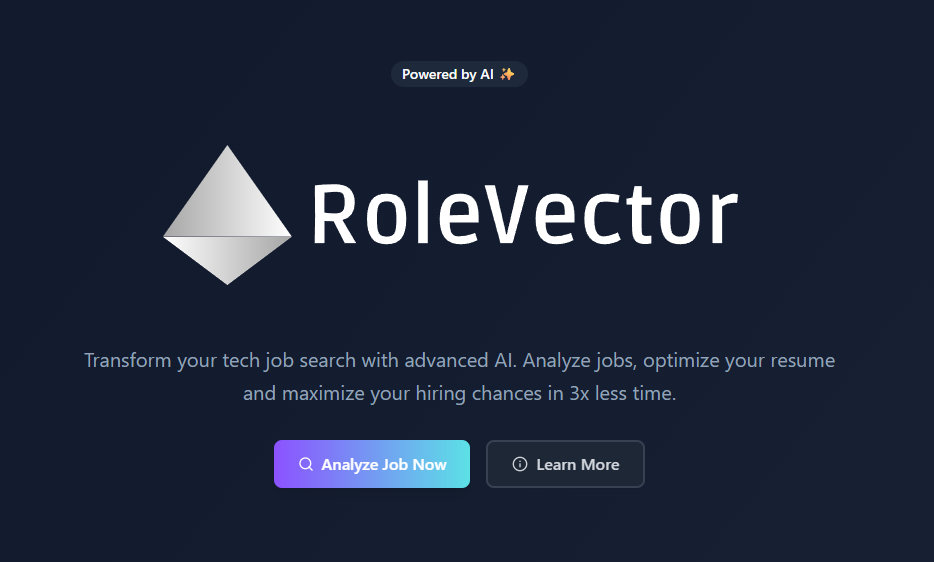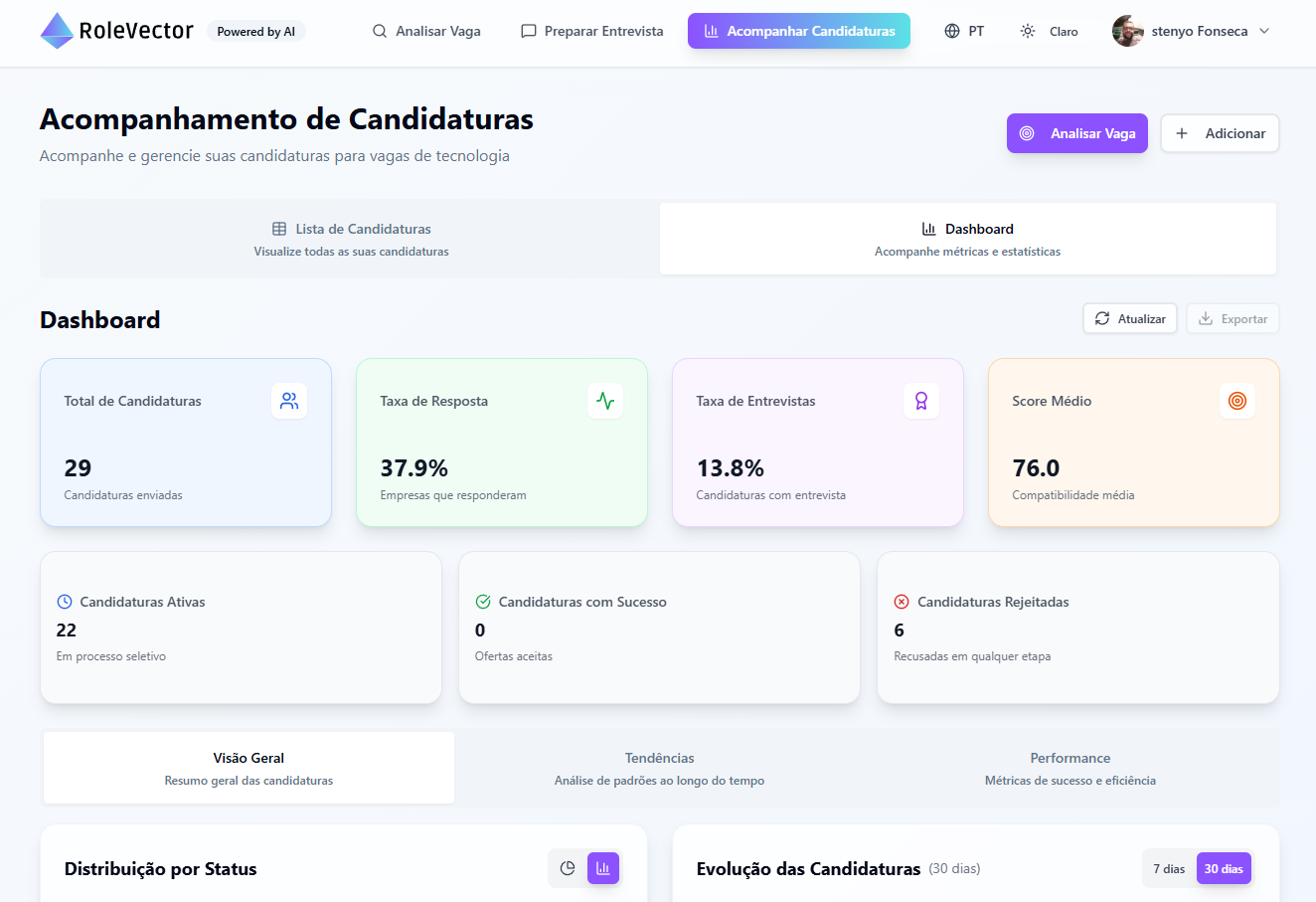I turned my job search into a product: the birth of RoleVector
Published on October 28, 2025

TL;DR
In 2025, I transformed the frustration of job hunting into a real product: RoleVector.com. This article tells the complete journey, from problem to solution, through hypotheses, architecture, design choices, initial metrics and next steps.
Why this project exists
During career transition, I noticed three recurring pains in job searching:
Low clarity on "where to apply"
It was difficult to prioritize opportunities with technical and contextual fit (stack, seniority, product context, squad type).
Generic resume vs. specific job
Adjusting the resume for each description took time and energy. ATS (Applicant Tracking Systems) penalize lack of textual adherence.
Funnel disorganization
Spreadsheets and loose notes fragmented the journey: where I applied, when, who I talked to, what status.
The question that guided everything: how to transform this flow into a system that better decides where to apply, automatically optimizes the resume and orchestrates the funnel end-to-end?
Hypotheses that shaped the MVP
Hypothesis 1: Selection matters more than volume.
Increasing application quality has more impact than expanding quantity.
Hypothesis 2: Resume personalization is decisive.
A resume contextualized for the job increases callback rates.
Hypothesis 3: Guidance reduces anxiety and accelerates execution.
A guided assistant (pre and post-application) shortens time between reading the job and a high-quality application.
Hypothesis 4: A candidate knowledge base avoids rework.
Storing experiences, projects and metrics in structured format allows quick reuse in resume adjustments and interview preparation.
Product principles
- Time is currency. Everything should happen in a few clicks.
- Radical clarity. Minimalist interface, direct language, no "opaque magic".
- Modularity. Each piece of the flow works alone, but shines together.
- Privacy and control. User data, prompts and histories under clear governance.
- Measurement from day zero. Metrics instrumented in the MVP.
What RoleVector does (today)
Decides when it's worth applying
Analyzes the job and calculates fit based on explicit criteria (requirements, seniority, context) and textual signals.
Optimizes resume for ATS
Generates contextual adjustments to titles, bullets and keywords — maintaining candidate's voice and history.
Organizes the search funnel
Dashboard with status per job, reminders, notes and interaction history.
Prepares interviews with real context
Generates scripts, questions and answers anchored in the actual job and optimized resume.
Technical architecture (pragmatic MVP)
The proposal was to build fast, with reliability and room to evolve.
Architecture Flow:
- Job (URL or text) → Parser & Normalizer
- Feature Extractor → Vector Embeddings
- Scoring & Heuristics → Apply or not?
- Yes → Resume optimizer
- No → Insights & Gaps -> Analyze another job
- Dashboard & Tracker → Interview preparation
Stack and decisions
Frontend & App: Next.js
Reason: development speed, app dir routes, Server Actions when useful.
AI: OpenAI APIs
Reason: orchestrated prompts, few-shot and analysis layers (quick → detailed).
RAG and Embeddings
Reason: use the candidate's own context (experiences, metrics, projects) for consistent personalization.
Cache
Reason: reduce latency and costs — cache analyses (TTL 24h), keywords and resume parsing.
Observability
Logs of prompts, latency per functionality, error rate per funnel step.
Note: In parallel, I integrate services like SMTP (via Google + Supabase) for transactional email and reminders.
Experience design
- Linear and short flow: paste job → see fit → optimize resume → register application
- Direct copy: objective labels, no unnecessary jargon.
- Immediate feedback: scores, rationale and "what to do now".
Security, privacy and ethics
- User-controlled data: export, deletion and visibility of what is stored.
- Auditable prompts: minimal logging for diagnosis without exposing sensitive content.
- Responsible AI use: light explainability (why the score is what it is).
MVP → initial results
- Immediate effect: my interview rate almost tripled after adopting the system.
- Value signal: reduced time between reading the job and application with aligned resume.
- Less anxiety, more cadence: with clear guidance and agenda, the process became sustainable.
Metrics that matter (and why)
- Application Quality Rate (AQR): % of applications with high fit.
- Callback Rate (CBR): % of positive/valid responses.
- Time-to-Apply (TTA): time from job paste to final application.
- Resume Reuse Ratio (RRR): how much of the optimized resume comes from candidate's knowledge base.
- Interview Readiness Score (IRS): coverage of key questions with contextualized examples.

Metrics dashboard showing AQR, CBR, TTA and other key metrics
What didn't make it (yet)
Job marketplaces and large-scale scraping
I chose bring-your-own-link in the MVP to reduce blocking risk and maintain focus on core value.Native integrations with LinkedIn/Glassdoor/Greenhouse
They're on the roadmap; priority was getting the core loop right.Purely automatic job matching
Human curation remains important; the system recommends and explains, doesn't "decide for me".
Roadmap (short → medium term)
- Interview playbooks by function (PM, Eng, Data, Design) with examples anchored in candidate's real stories.
- Reusable metrics and bullets packages by delivery type (growth, retention, pricing, AI/ML).
- Integrations (calendar, email, ATSs) to close the loop with less manual work.
- Explainability improvements (why is your fit X? what gaps? how to close the gap in 7 days?).
- "Living Portfolio" mode: public page with dynamic cases generated from knowledge base.
Lessons learned
- The pain is real and emotional. The product needs to reduce friction and anxiety.
- MVP is about focus. Solving 1–2 critical moments creates traction; the rest comes later.
- Context is king. Personalizing with your history changes the game against ATS and recruiter.
- Measure from the start. Without metrics, there's no iteration — just intuition.
Call to community
If you're also in transition or want to accelerate your search:
- Test RoleVector and tell me: what helped you? what was missing?
- Send a real job you're evaluating: I want to expand the playbooks.
- Give feedback on the experience: time, language, guidance clarity.
Credits and acknowledgments
To all the people who gave feedback on the first versions — you helped transform a draft into a usable product.